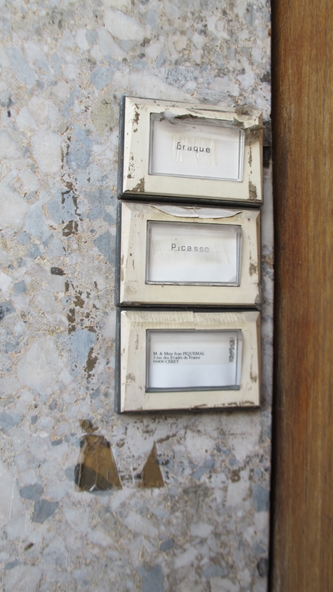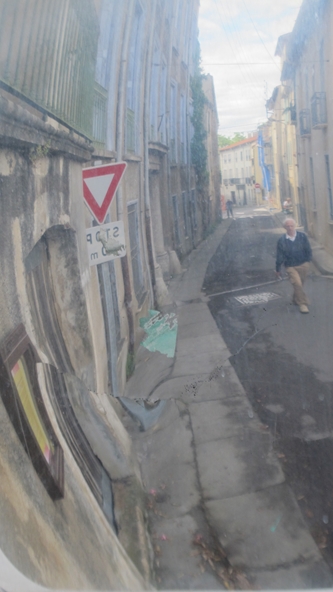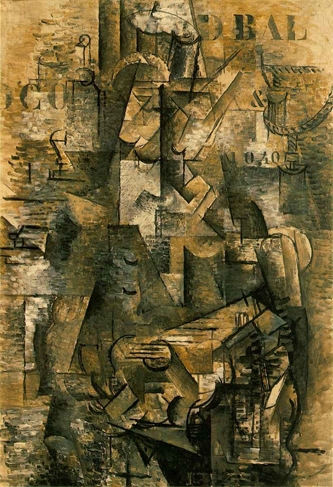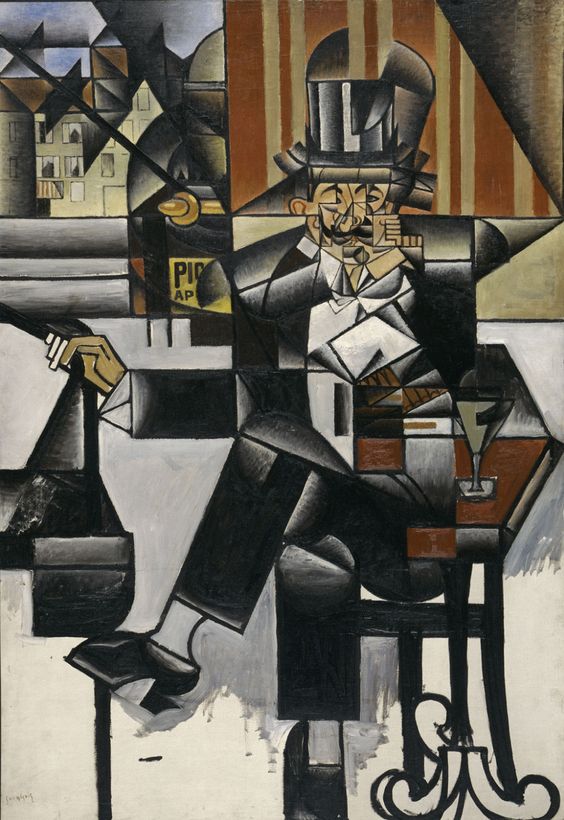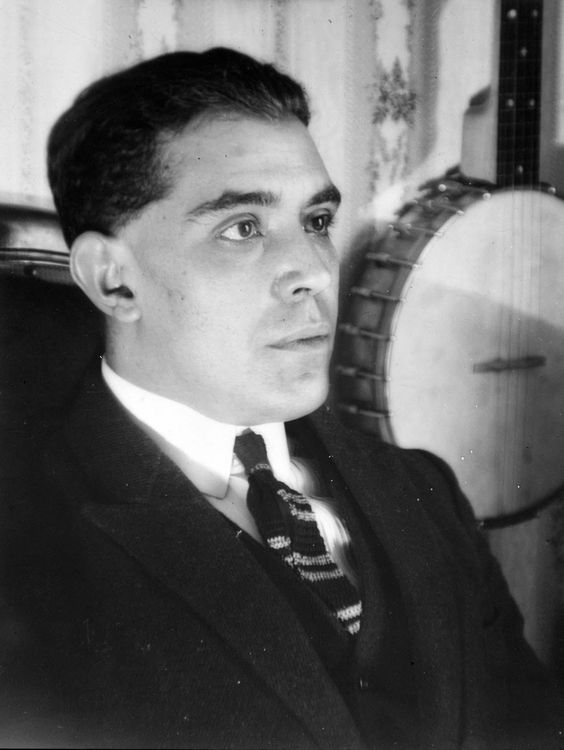The town of Céret in the Pyrenees, “The Mecca of Cubism.” Photo Travellati Tours.
Picasso spent several weeks in the Spring/Summer of 1911, 1912, and 1913 in the little town of Céret in the foothills of the eastern Pyrenees, within an hour of the Mediterranean. He came at the invitation of art patron and artist Frank Haviland, who had been introduced to Céret by local sculptor Manolo Huguet/Hugué (aka “Manolo”). Picasso brought along his buddy and art collaborator, Georges Braque, with whom he was developing a revolutionary art form: cubism.
From left: Manolo Huguet on poster for Musée d'Art Moderne, Pablo Picasso, 1957. Head of Frank Burty Haviland, Manolo Huguet.
They had first gone to the lovely seaside town of Banyuls, near the Spanish border, the home town of the sculptor Aristide Maillol, but found the strong Tramontane wind unnerving. They went to the thermal resort town of Amélie-les-bains but left due to the unhealthy aspect of mixing with tuberculosis patients. They also traveled to the little village of Gosol, high in the Pyrenees, but it was too remote to reach easily.
From top: The harbor at Banyuls. Girl Lying on the Sand by Maillol at Banyuls. Old fashioned fishing boats at Banyuls sporting “blood and gold” Catalonian flags. Photo Travellati Tours.
They visited Matisse and Derain who were pursuing their experiments in Fauvism in the fort and port town of Collioure. Gertrude Stein, the salonist, idiosyncratic writer, and art collector, visited them there.
From top: The fort at Collioure on the Mediterranean. Thunderstorm over the Pyrenees near Collioure. The bay from which Matisse and Derain painted at Collioure. Photo Travellati Tours.
Picasso and Braque finally settled on Céret, an easily accessible and charming little town in a large house with a large garden and fine views on one of the narrow medieval streets. For the next 40 years, Céret was an important art colony that welcomed artists such as Chaim Soutine, who stayed three years after the death of his best friend, Modigliani, and painted about 200 landscapes; Marc Chagal, and dozens of others.
Clockwise from top: Picasso and Braque’s house in Céret. Nameplates for Picasso and Braque on their house. Reflection of Picasso and Braque’s house (on left). Photo Travellati Tours.
h the revolutionary and controversial Demoiselles d’Avignon, he further developed his ideas along with Braque while in Céret until they reached the extremely abstract form of analytical cubism.
From left: Landscape at Céret, Pablo Picasso, summer 1911. Le Portugais (The Portuguese Man), Georges Braque.
Juan Gris was also one of the notable cubists who came to Céret in the early teens and then again in the ‘20s. Apparently he was very disappointed one year because the local girls didn’t know how to do the latest dance craze from Paris: the Charleston. According to Gertrude Stein, “Juan Gris was the only person that Picasso wished away,” yet Picasso mourned Gris at his funeral: “…Gertrude Stein said to him bitterly, you have no right to mourn, and he said, you have no right to say that tome.” (From The Autobiography of Alice B. Toklas by Gertrude Stein.)
From left: Man in a Café, Juan Gris, 1912. Photo of Juan Gris.
In 1950, the Modern Art Museum of Céret was founded, with works contributed by most of the artists who had sojourned there. Picasso returned to Céret in 1953 and executed his famous “Sardane de la Paix” drawing at the Grand Café and then donated it to the museum. A fourteen year old boy caught the occasion on his Polaroid. Today the museum hosts a revolving permanent collection of these works, as well as a large installation of temporary exhibits, the current one being on Salvador Dalí, the Catalonian artist from right over the Spanish border. The nearby coastal town of Perpignan is currently hosting a Picasso exhibit as well as various exhibits of photos of Picasso around town.
From top: Musée d’art Moderne de Céret. Photo Travellati Tours. One of the many Picasso ceramic bowls at the Céret Modern Art Museum. Photo Travellati Tours. Landscape with Bridge, Picasso, Spring 1909, reminiscent of Céret .
In 1965, Dalí and his entourage entered town in a horse drawn wagon to present a giant cardboard rhinoceros to the residents of Céret. The residents worked for weeks to make paper butterflies and bugs with which to festoon the town in preparation for Dalí’s arrival. Dalí created a skeleton in which was hidden a little girl who peeked out from its chest when the ribs were pushed aside. The little girl later said this was the longest day of her life. The skeleton was rigged to present a rose to the mayor of Céret, Michel Sagelolli, the owner of the local hardware store that sold paints to artists.
Salvador Dalí riding in a horse drawn cart with Amanda Lear in Céret, 1965.
For art lovers, there has never been a better time to visit Céret than now, with the special exhibits on Picasso and Dalí now on offer in this beautiful corner of France. Join us when we visit Céret and its environs for our Picasso’s Pyrenees Tour!
The Porte de France (door of France) in the medieval ramparts of Céret with two 200-year-old plane trees. Photo Travellati Tours.
We will make our home base in a cozy hotel in Céret and take several day trips from there. We’ll visit:
- Art related sites in and around Céret
- The Modern Art Museum of Céret
- Banyuls where we will walk in the footsteps of Maillol, visit the Maillol Museum, and partake in tastings of the local fortified wine, “Banyuls”
- Collioure and take a docent-led tour of sites related to Matisse, Derain, and Picasso
- Figueres, Dalí’s amazing home and museum just over the Pyrenees in Catalonian Spain
- Perpignan, where we will view the Picasso exhibits and other art-related sites
- Two days of festivities in Céret, with 30 Catalonian lace makers, Sardane dances, musicians, food, wine, and general craziness.
- Three theatrical/dance/musical interactions.
From top: Our cheerful hosts, Jonathan and Cécilia. View from hotel room on the Place Picasso and the arcades in the medieval wall surrounding Céret. Deluxe room at our hotel. Photo Travellati Tours.
You can fly into Paris and take the TGV high-speed train to Perpignan (5 hours) or into Barcelona and take the TGV to Perpignan (< 1 hour). We’ll pick you up at the train station (dubbed “The Center of the World” by Dalí) and escort you to our aerie in the mountains. We’ll wine you, dine you, and feast on the beauties of art and nature.
The Roman town of Nimes from the TGV. Photo Travellati Tours.
Also on offer: a reprise of our Papa’s Paris Tour – Ernest Hemingway, Gertrude Stein, and the Fitzgeralds are looking forward to our return!
Gertrude Stein (Constance Bradburn) and Ernest Hemingway (David Coburn) entertain our tour group in the Luxembourg Gardens. Photo Travellati Tours.
And please take a moment to introduce us to friends or family members who would love our tours. They will thank you, and we will thank you with a generous referral bonus.
From top: At Le France café, Céret. At an outdoor restaurant in Céret. Photos Travellati Tours.










